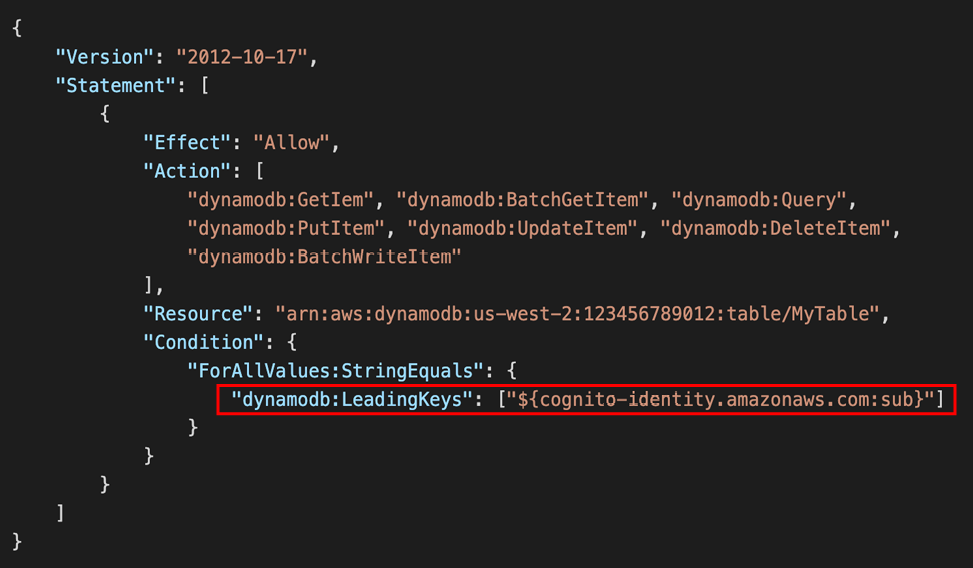DynamoDB
- Fully managed, highly available with replication across multiple AZs
- NoSQL database - not a relational database
- Scales to massive workloads, distributed database
- Millions of requests per seconds, trillions of row, 100s of TB of storage
- Fast and consistent in performance (low latency on retrieval)
- Integrated with IAM for security, authorization and administration
- Enables event driven programming with DynamoDB Streams
- Low cost and auto-scaling capabilities
- Standard & Infrequent Access (IA) Table Class
Basics
- DynamoDB is made of Tables
- Each table has a Primary Key (must be decided at creation time)
- Each table can have an infinite number of items (= rows)
- Each item has attributes (can be added over time – can be null)
- Maximum size of an item is 400KB
- Data types supported are:
- Scalar Types – String, Number, Binary, Boolean, Null
- Document Types – List, Map
- Set Types – String Set, Number Set, Binary Set
Primary Keys
- Option 1: Partition Key (HASH)
- Partition key must be unique for each item
- Partition key must be “diverse” so that the data is distributed
- Example: “User_ID” for a users table
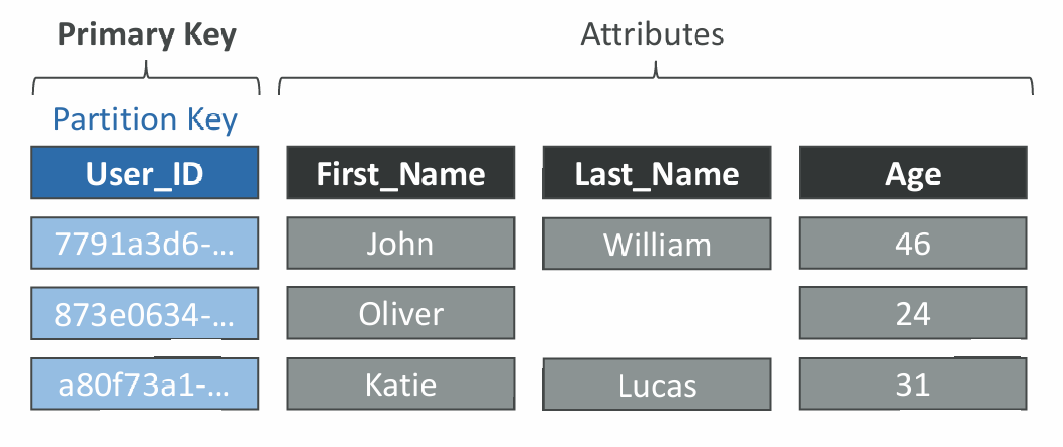
- Option 2: Partition Key + Sort Key (HASH + RANGE)
- The combination must be unique for each item
- Data is grouped by partition key (key with highest cardinality is a good candidate)
- Example: users-games table, “User_ID” for Partition Key and “Game_ID” for Sort Key

Writing Data
- PutItem
- Creates a new item or fully replace an old item (same Primary Key)
- Consumes WCUs
- UpdateItem
- Edits an existing item’s attributes or adds a new item if it doesn’t exist
- Can be used to implement Atomic Counters – a numeric attribute that’s unconditionally incremented
- Conditional Writes
- Accept a write/update/delete only if conditions are met, otherwise returns an error
- Helps with concurrent access to items
- No performance impact
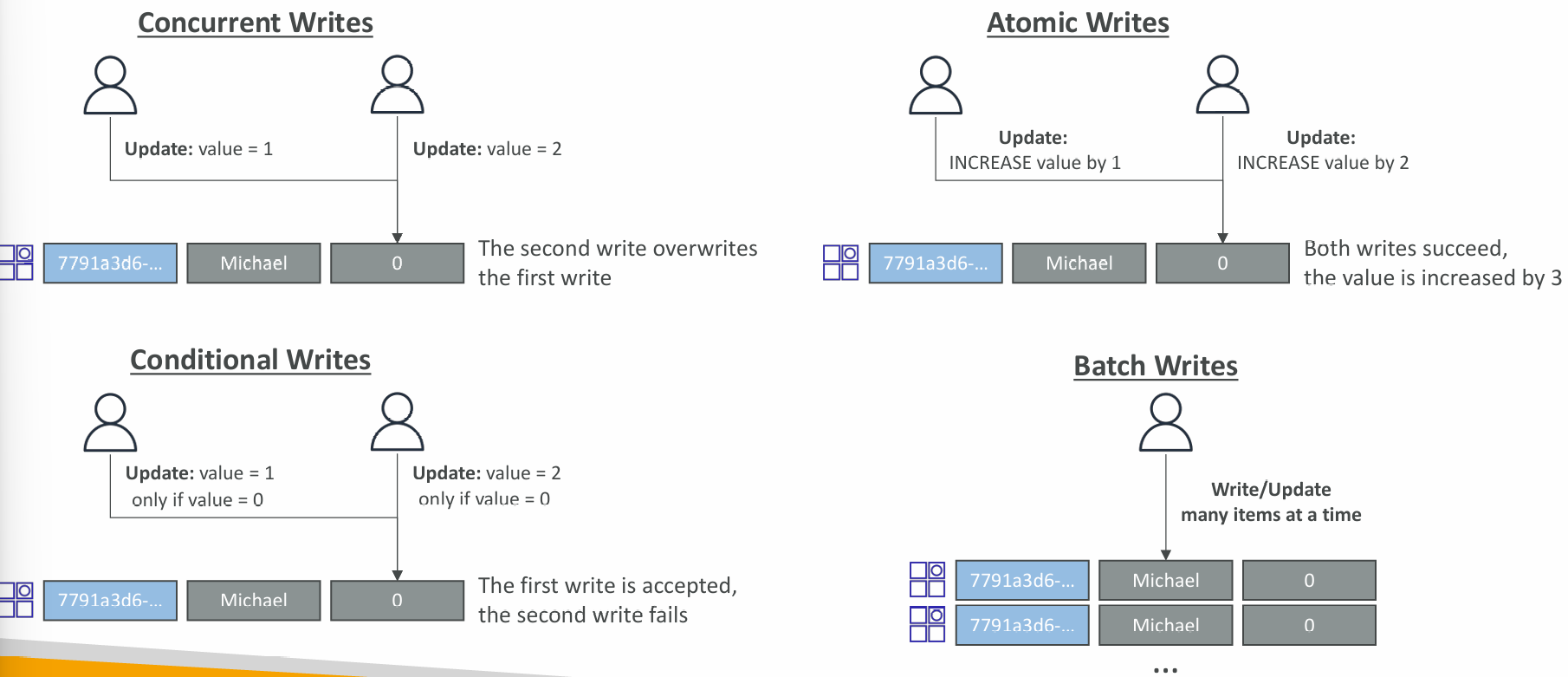
Reading Data
- GetItem
- Read based on Primary key
- Primary Key can be HASH or HASH+RANGE
- Eventually Consistent Read (default)
- Option to use Strongly Consistent Reads (more RCU - might take longer)
- ProjectionExpression can be specified to retrieve only certain attributes
Query
- Query returns items based on:
- KeyConditionExpression
- Partition Key value (must be = operator) - required
- Sort Key value (=, <, <=, >, >=, Between, Begins with) - optional
- FilterExpression
- Additional filtering after the Query operation (before data returned to you)
- Use only with non-key attributes (does not allow HASH or RANGE attributes)
- KeyConditionExpression
- Returns:
- The number of items specified in Limit
- Or up to 1 MB of data
- Ability to do pagination on the results
- Can query table, a Local Secondary Index, or a Global Secondary Index
Scan
- Scan the entire table and then filter out data (inefficient)
- Returns up to 1 MB of data – use pagination to keep on reading
- Consumes a lot of RCU
- Limit impact using Limit or reduce the size of the result and pause
- For faster performance, use Parallel Scan
- Multiple workers scan multiple data segments at the same time
- Increases the throughput and RCU consumed
- Limit the impact of parallel scans just like you would for Scans
- Can use ProjectionExpression & FilterExpression (no changes to RCU)
Deleting Data
- DeleteItem
- Delete an individual item
- Ability to perform a conditional delete
- DeleteTable
- Delete a whole table and all its items
- Much quicker deletion than calling DeleteItem on all items
Batch Operations
- Allows you to save in latency by reducing the number of API calls
- Operations are done in parallel for better efficiency
- Part of a batch can fail; in which case we need to try again for the failed items
- BatchWriteItem
- Up to 25 PutItem and/or DeleteItem in one call
- Up to 16 MB of data written, up to 400 KB of data per item
- Can’t update items (use UpdateItem)
- UnprocessedItems for failed write operations (exponential backoff or add WCU)
- BatchGetItem
- Return items from one or more tables
- Up to 100 items, up to 16 MB of data
- Items are retrieved in parallel to minimize latency
- UnprocessedKeys for failed read operations (exponential backoff or add RCU)
Time To Live (TTL)
- Automatically delete items after an expiry timestamp
- Doesn’t consume any WCUs (i.e., no extra cost)
- The TTL attribute must be a “Number” data type with “Unix Epoch timestamp” value
- Expired items deleted within 48 hours of expiration
- Expired items, that haven’t been deleted, appears in reads/queries/scans (if you don’t want them, filter them out)
- Expired items are deleted from both LSIs and GSIs
- A delete operation for each expired item enters the DynamoDB Streams (can help recover expired items)
- Use cases: reduce stored data by keeping only current items, adhere to regulatory obligations, …
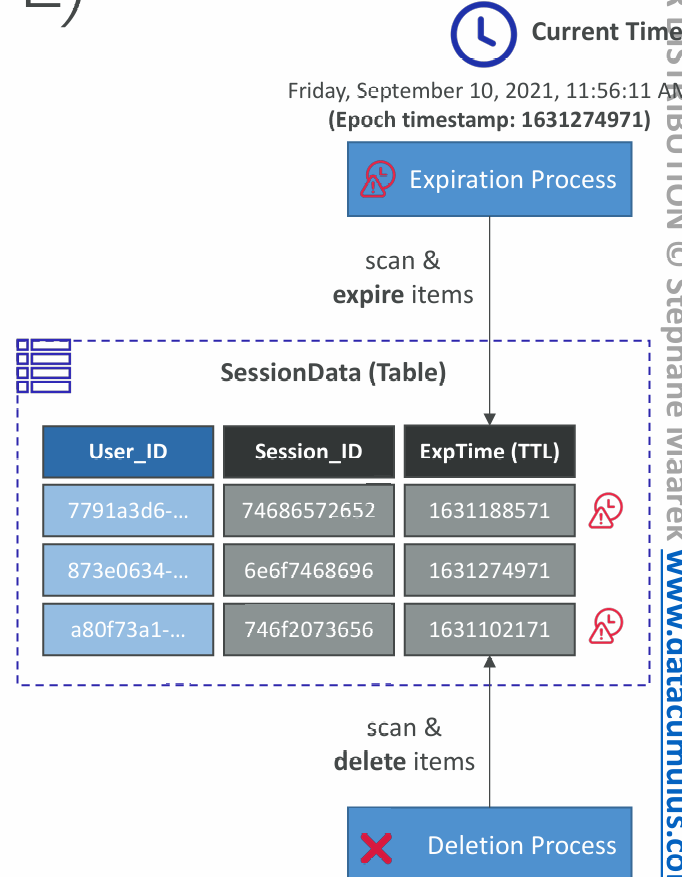
Transactions
- Coordinated, all-or-nothing operations (add/update/delete) to multiple items across one or more tables
- Provides Atomicity, Consistency, Isolation, and Durability (ACID)
- Read Modes – Eventual Consistency, Strong Consistency, Transactional
- Write Modes – Standard, Transactional
- Consumes 2x WCUs & RCUs
- DynamoDB performs 2 operations for every item (prepare & commit)
- Two operations:
- TransactGetItems – one or more GetItem operations
- TransactWriteItems – one or more PutItem, UpdateItem, and DeleteItem operations
- Use cases: financial transactions, managing orders, multiplayer games, …
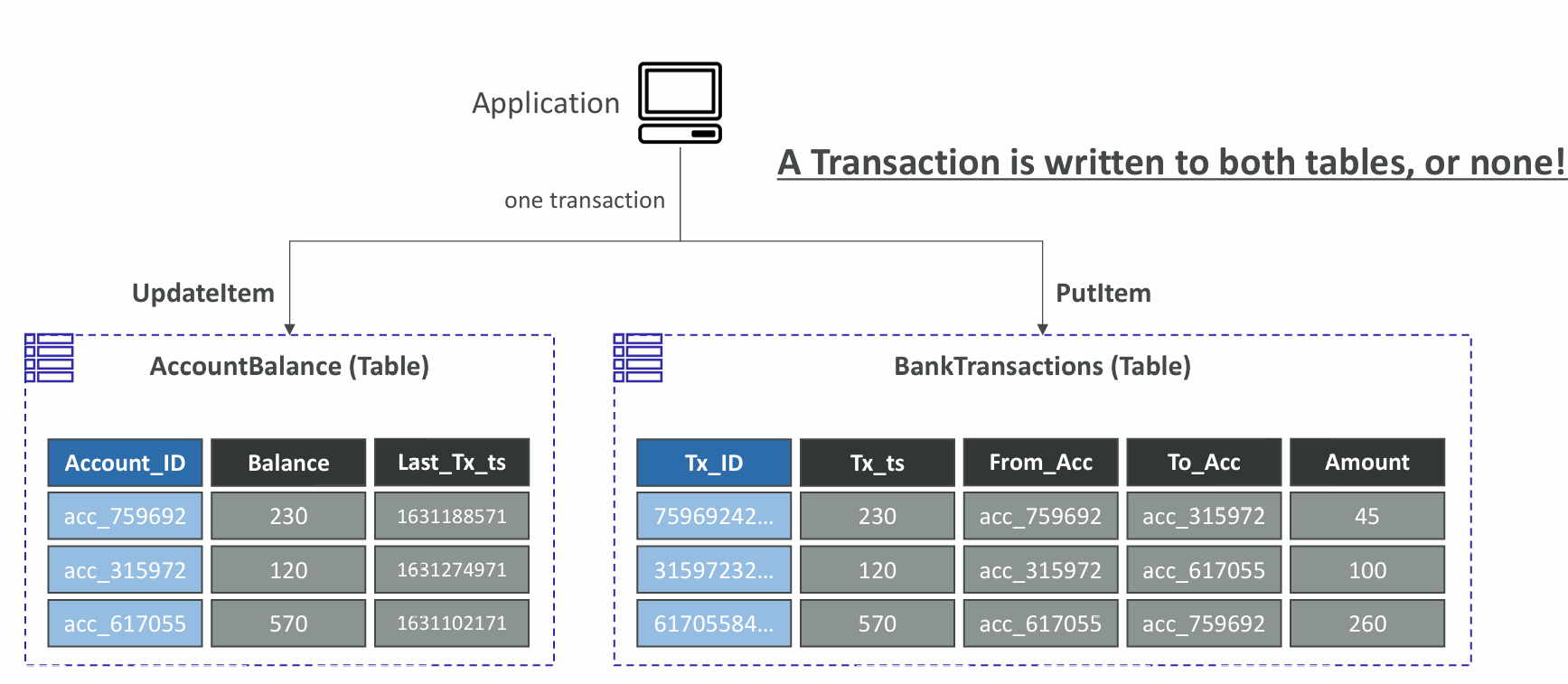
Capacity Computations
Important
This is important for the exam

Read/Write Capacity Modes
- Control how you manage your table’s capacity (read/write throughput)
- Provisioned Mode (default)
- You specify the number of reads/writes per second
- You need to plan capacity beforehand
- Pay for provisioned
- On-Demand Mode read & write capacity units
- Read/writes automatically scale up/down with your workloads
- No capacity planning needed
- Pay for what you use, more expensive ($$$)
- You can switch between different modes once every 24 hours
R/W Capacity Modes – Provisioned
- Table must have provisioned read and write capacity units
- Read Capacity Units (RCU) – throughput for reads
- Write Capacity Units (WCU) – throughput for writes
- Option to setup auto-scaling of throughput to meet demand
- Throughput can be exceeded temporarily using “Burst Capacity”
- If Burst Capacity has been consumed, you’ll get a “ProvisionedThroughputExceededException”
- It’s then advised to do an exponential backoff retry
Write Capacity Units (WCU)
- One Write Capacity Unit (WCU) represents one write per second for an item up to 1 KB in size
- If the items are larger than 1 KB, more WCUs are consumed

Strongly Consistent Read vs. Eventually Consistent Read
- Eventually Consistent Read (default)
- If we read just after a write, it’s possible we’ll get some stale data because of replication
- Strongly Consistent Read
- If we read just after a write, we will get the correct data
- Set “ConsistentRead” parameter to True in API calls (GetItem, BatchGetItem, Query, Scan)
- Consumes twice the RCU
Read Capacity Units (RCU)
- One Read Capacity Unit (RCU) represents one Strongly Consistent Read per second, or two Eventually Consistent Reads per second, for an item up to 4 KB in size
- If the items are larger than 4 KB, more RCUs are consumed

Partitions Internal
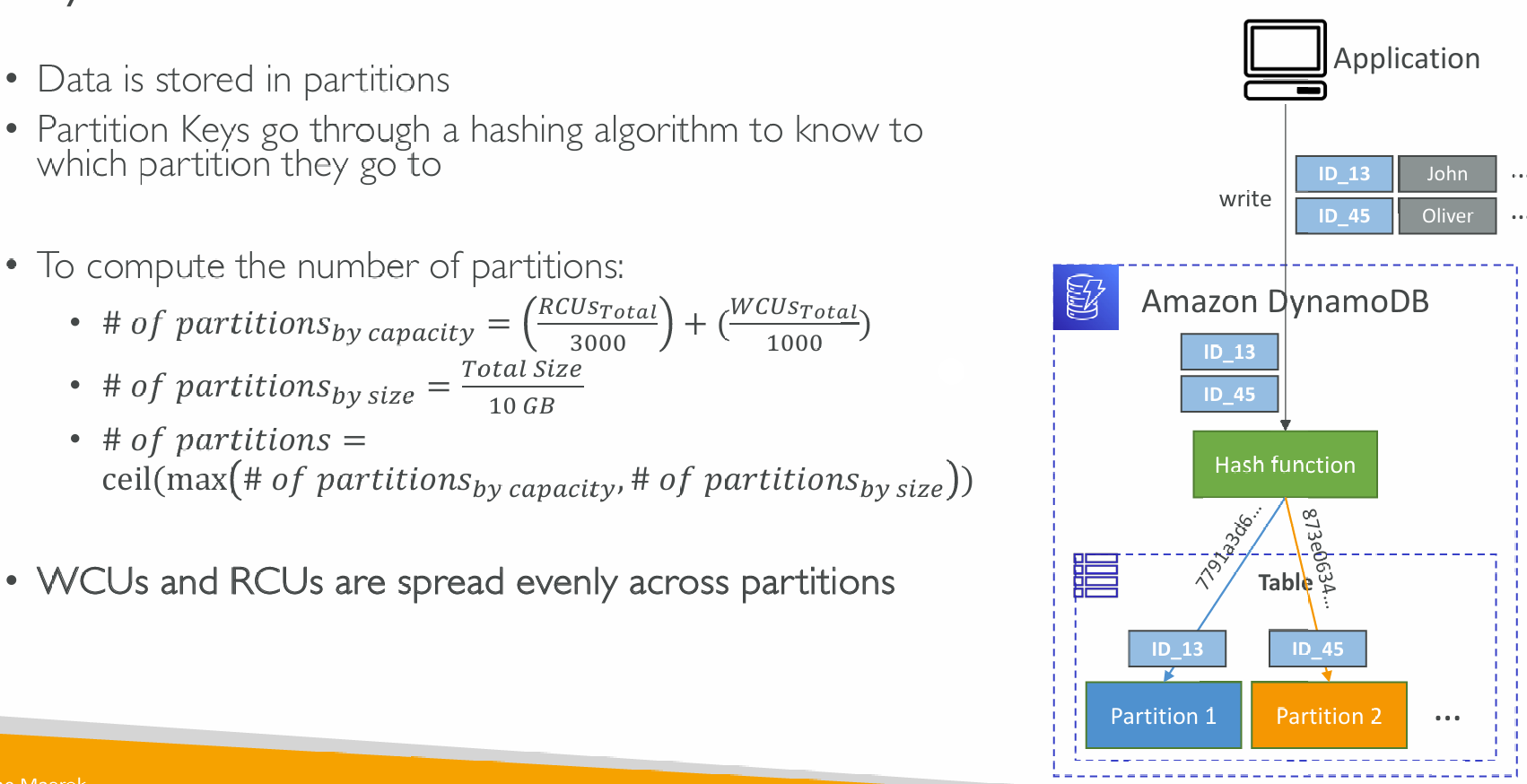
Throttling
- If we exceed provisioned RCUs or WCUs, we get “ProvisionedThroughputExceededException”
- Reasons:
- Hot Keys – one partition key is being read too many times (e.g., popular item)
- Hot Partitions
- Very large items, remember RCU and WCU depends on size of items
- Solutions:
- Exponential backoff when exception is encountered (already in SDK)
- Distribute partition keys as much as possible
- If RCU issue, we can use DynamoDB Accelerator (DAX)
R/W Capacity Modes – On-Demand
- Read/writes automatically scale up/down with your workloads
- No capacity planning needed (WCU / RCU)
- Unlimited WCU & RCU, no throttle, more expensive
- You’re charged for reads/writes that you use in terms of RRU and WRU
- Read Request Units (RRU) – throughput for reads (same as RCU)
- Write Request Units (WRU) – throughput for writes (same as WCU)
- 2.5x more expensive than provisioned capacity (use with care)
- Use cases: unknown workloads, unpredictable application traffic, …
PartiQL
- SQL-compatible query language for DynamoDB
- Allows you to select, insert, update, and delete data in DynamoDB using SQL
- Run queries across multiple DynamoDB tables
- Run PartiQL queries from:
- AWS Management Console
- NoSQL Workbench for DynamoDB
- DynamoDB APIs
- AWS CLI
- AWS SDK
- Supports some (but not all) statements:
- INSERT
- UPDATE
- SELECT
- DELETE
- It supports Batch operation
Conditional Writes
- DynamoDB has a feature called “Conditional Writes” (Optimistic Locking)
- A strategy to ensure an item hasn’t changed before you update/delete it
- Each item has an attribute that acts as a version number

- For PutItem, UpdateItem, DeleteItem, and BatchWriteItem
- You can specify a Condition expression to determine which items should be modified:
- attribute_exists
- attribute_not_exists
- attribute_type
- contains (for string)
- begins_with (for string)
- ProductCategory IN (:cat1, :cat2) and Price between :low and :high
- size (string length)
- Note: Filter Expression filters the results of read queries, while Condition Expressions are for write operations
Example on Update Item
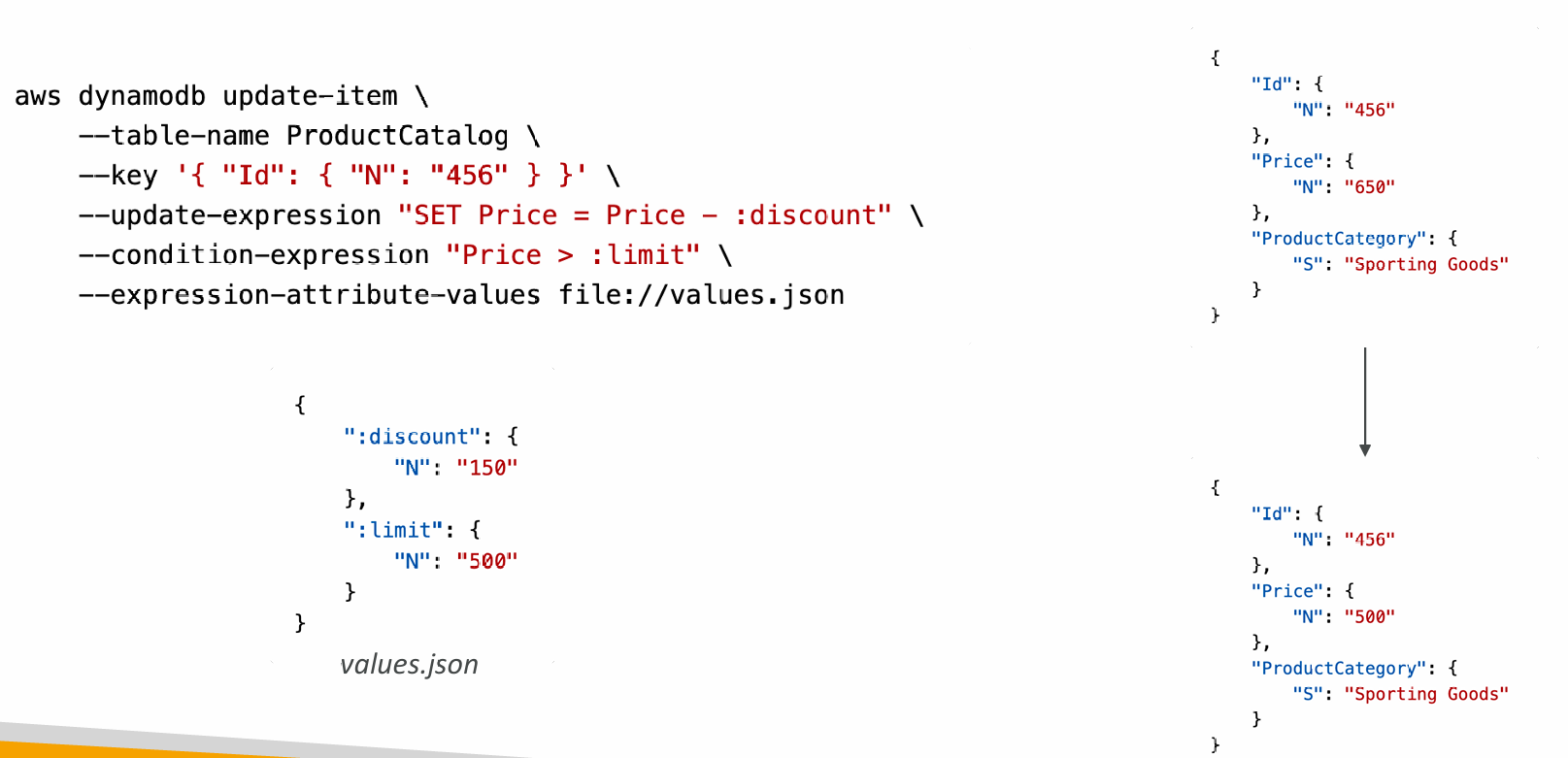
Example on Delete Item
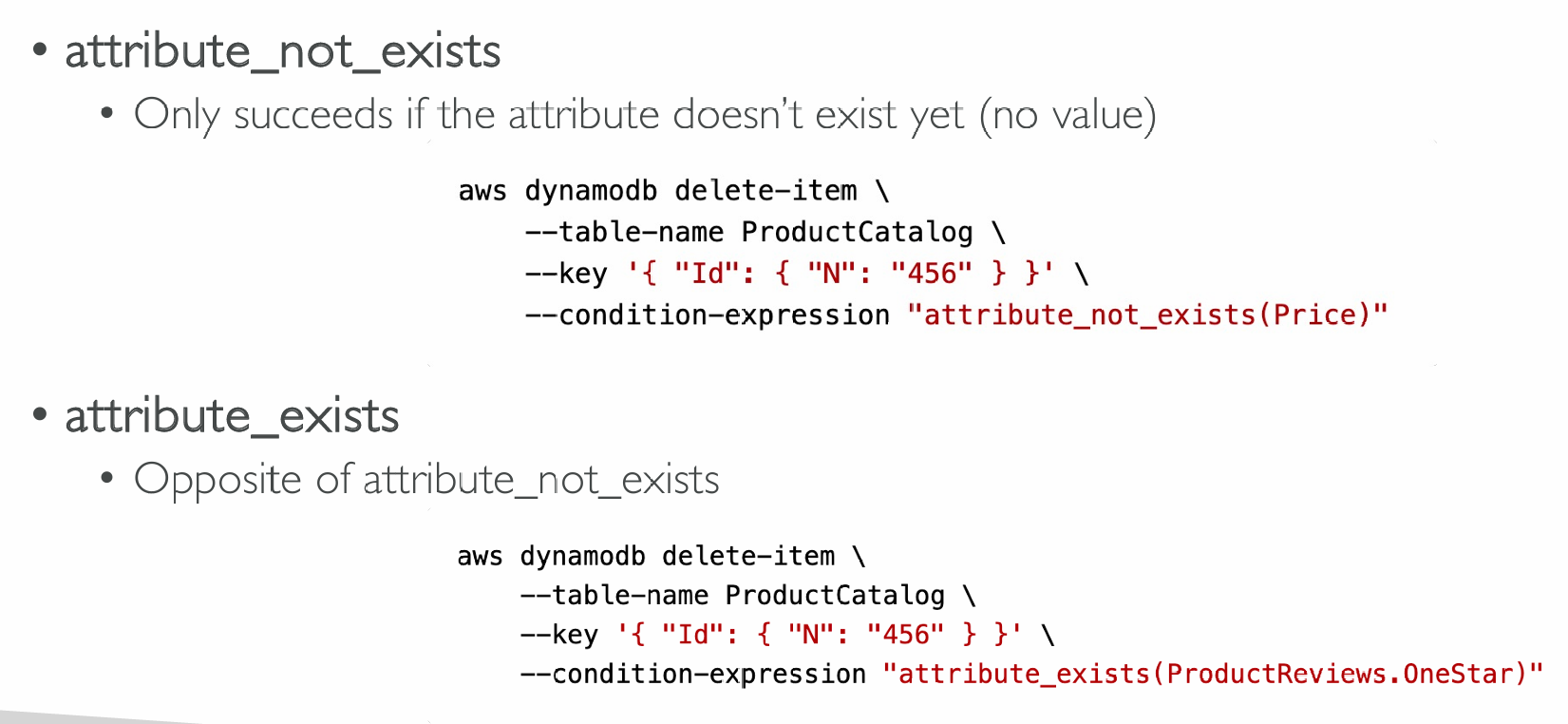
Do Not Overwrite Elements
- attribute_not_exists(partition_key)
- Make sure the item isn’t overwritten
- attribute_not_exists(partition_key) and attribute_not_exists(sort_key)
- Make sure the partition / sort key combination is not overwritten
Example Complex Condition
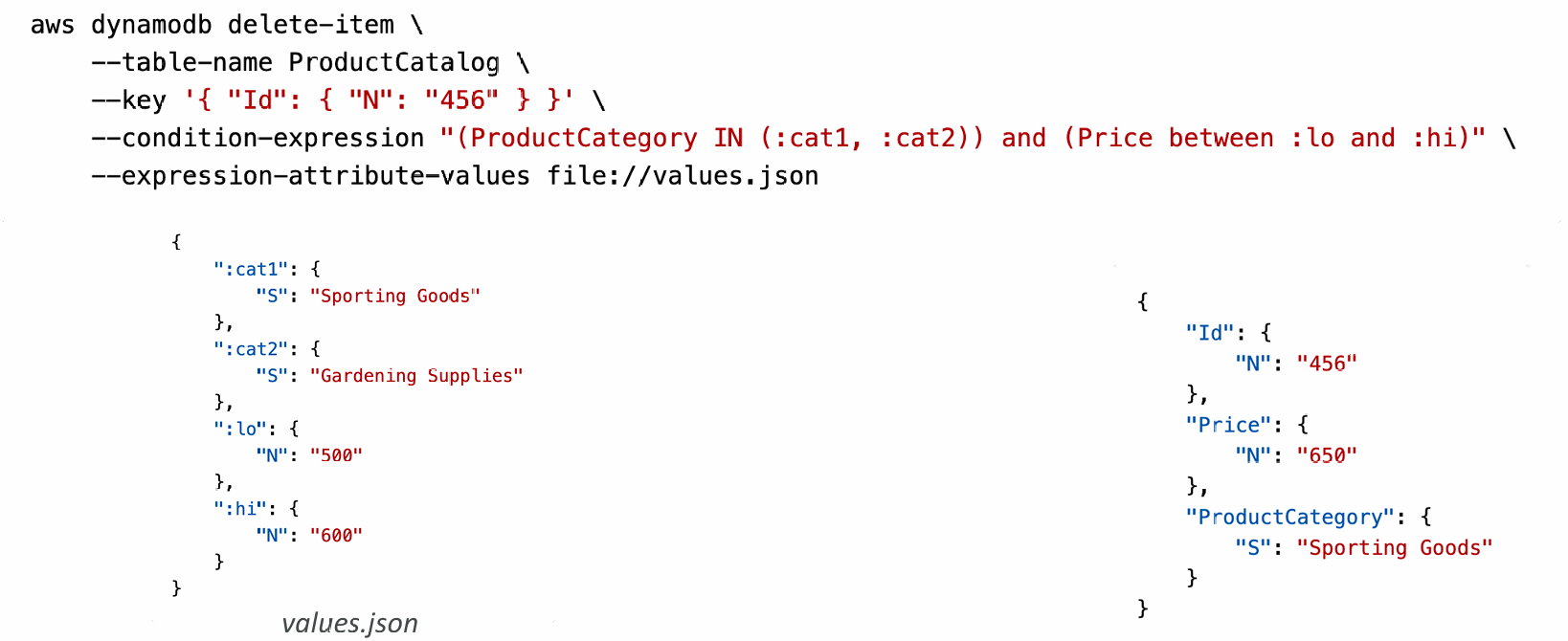
Example of String Comparisons
- begins_with – check if prefix matches
- contains – check if string is contained in another string
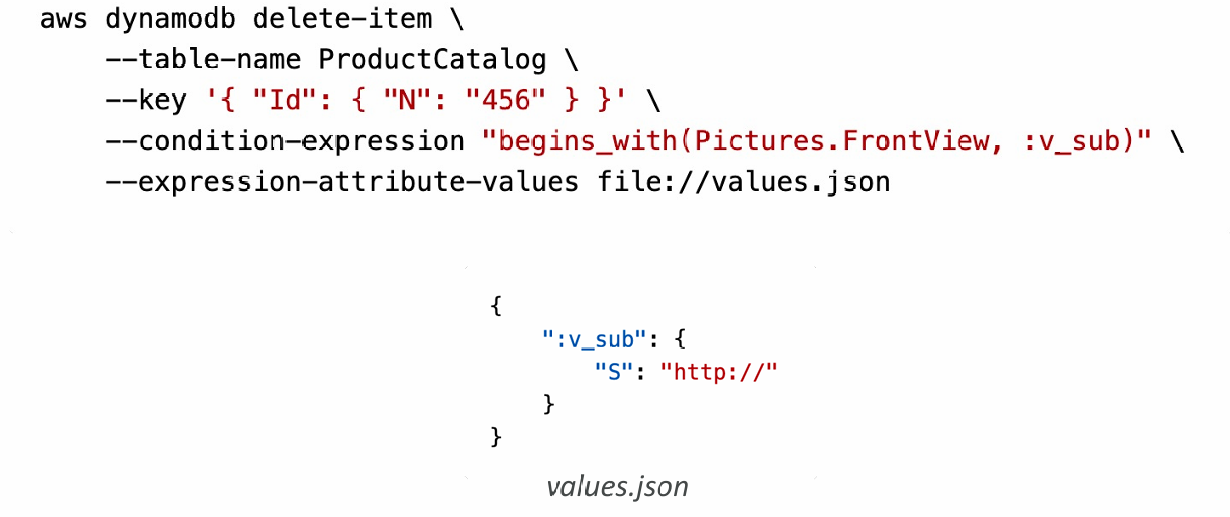
Secondary Indexes
Local Secondary Index (LSI)
- Alternative Sort Key for your table (same Partition Key as that of base table)
- The Sort Key consists of one scalar attribute (String, Number, or Binary)
- Up to 5 Local Secondary Indexes per table
- Must be defined at table creation time
- Attribute Projections – can contain some or all the attributes of the base table (KEYS_ONLY, INCLUDE, ALL)

Global Secondary Index (GSI)
- Alternative Primary Key (HASH or HASH+RANGE) from the base table
- Speed up queries on non-key attributes
- The Index Key consists of scalar attributes (String, Number, or Binary)
- Attribute Projections – some or all the attributes of the base table (KEYS_ONLY, INCLUDE, ALL)
- Must provision RCUs & WCUs for the index
- Can be added/modified after table creation

Indexes and Throttling
- Global Secondary Index (GSI):
- If the writes are throttled on the GSI, then the main table will be throttled!
- Even if the WCU on the main tables are fine
- Choose your GSI partition key carefully!
- Assign your WCU capacity carefully!
- Local Secondary Index (LSI):
- Uses the WCUs and RCUs of the main table
- No special throttling considerations
DynamoDB Accelerator (DAX)
- Fully-managed, highly available, seamless in-memory cache for DynamoDB
- Microseconds latency for cached reads & queries
- Doesn’t require application logic modification (compatible with existing DynamoDB APIs)
- Solves the “Hot Key” problem (too many reads)
- 5 minutes TTL for cache (default)
- Up to 10 nodes in the cluster
- Multi-AZ (3 nodes minimum recommended for production)
- Secure (Encryption at rest with KMS, VPC, IAM, CloudTrail, …)
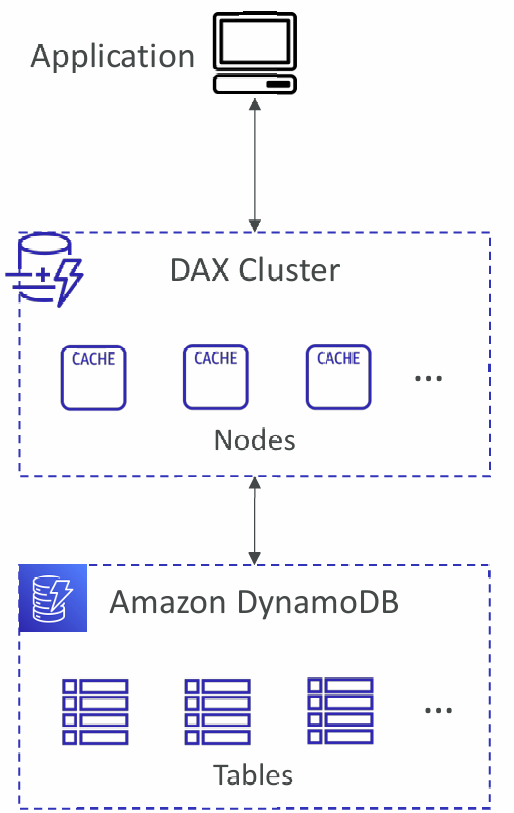
DynamoDB Accelerator (DAX) vs. ElastiCache:
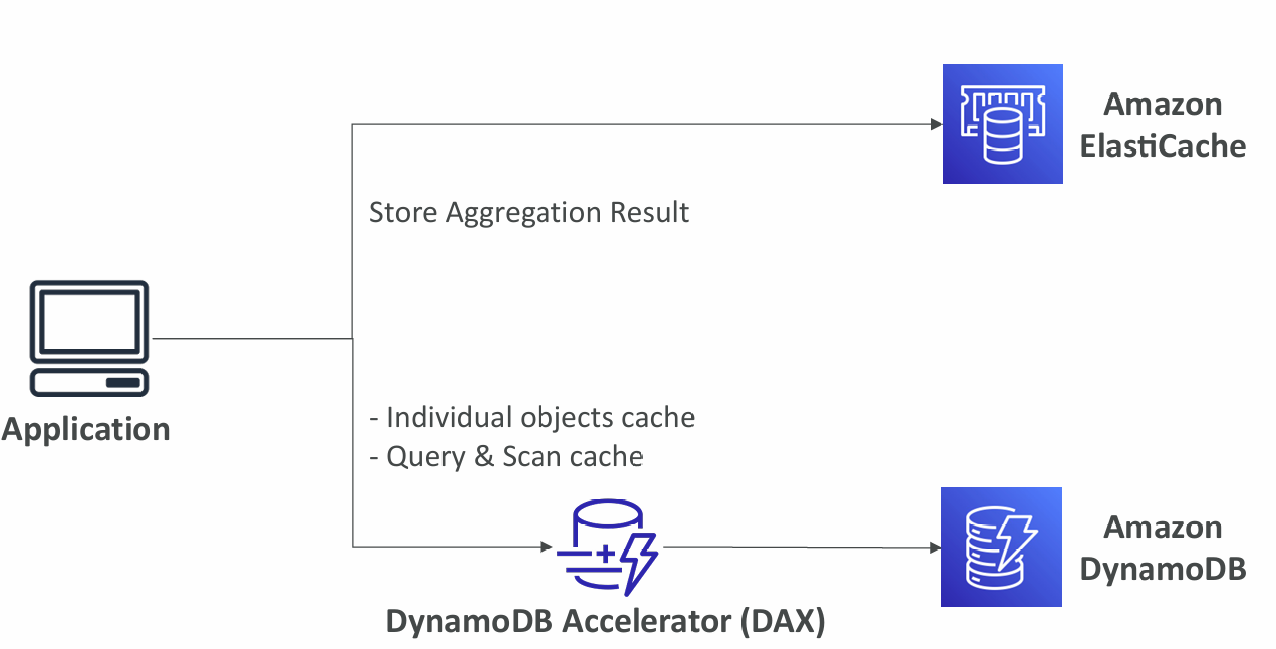
DynamoDB Streams
- Ordered stream of item-level modifications (create/update/delete) in a table
- Stream records can be:
- Sent to Kinesis Data Streams
- Read by AWS Lambda
- Read by Kinesis Client Library applications
- Data Retention for up to 24 hours
- Use cases:
- react to changes in real-time (welcome email to users)
- Analytics
- Insert into derivative tables
- Insert into OpenSearch Service
- Implement cross-region replication
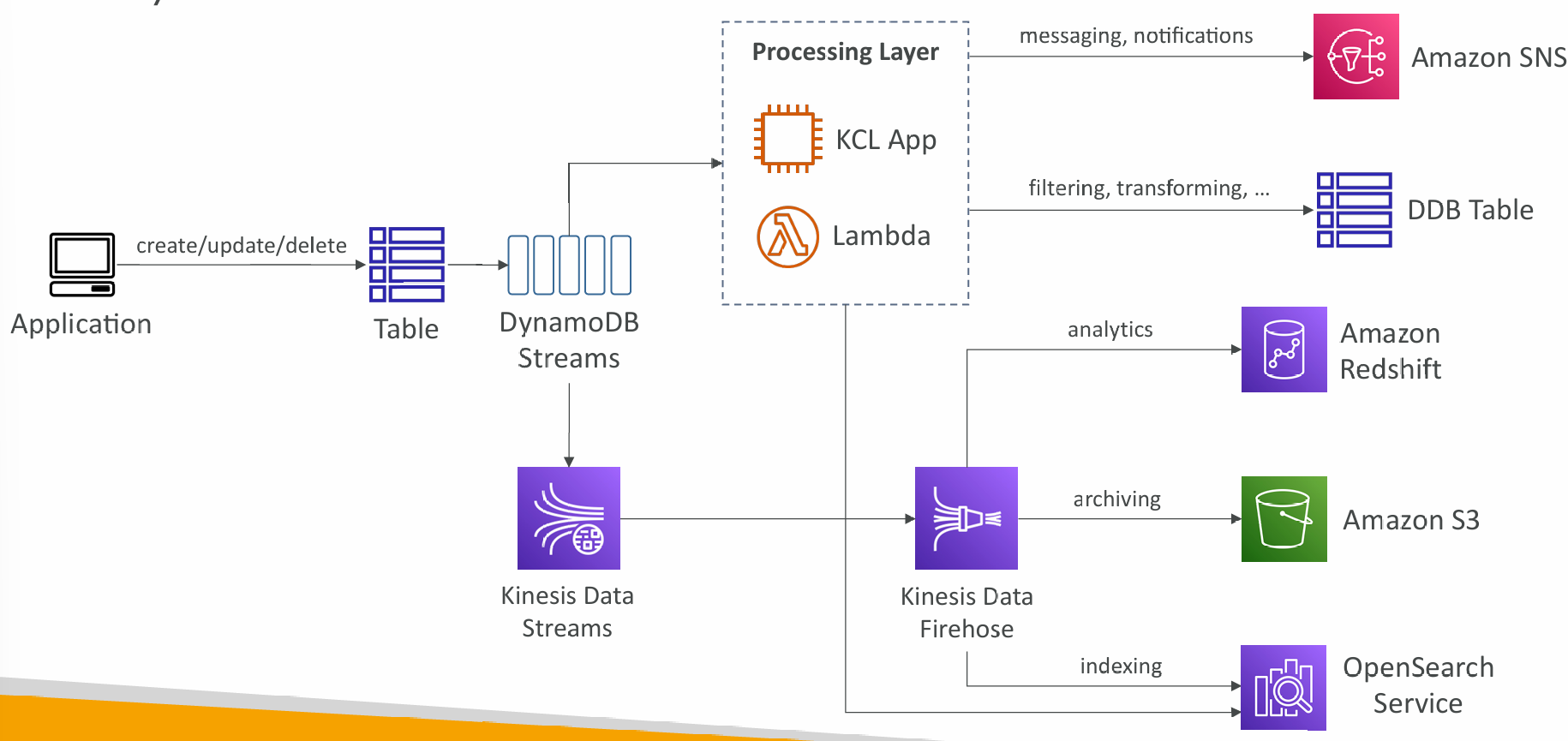
- Ability to choose the information that will be written to the stream:
- KEYS_ONLY – only the key attributes of the modified item
- NEW_IMAGE – the entire item, as it appears after it was modified
- OLD_IMAGE – the entire item, as it appeared before it was modified
- NEW_AND_OLD_IMAGES – both the new and the old images of the item
- DynamoDB Streams are made of shards, just like Kinesis Data Streams
- You don’t provision shards, this is automated by AWS
- Records are not retroactively populated in a stream after enabling it
DynamoDB Streams & AWS Lambda
- You need to define an Event Source Mapping to read from a DynamoDB Streams
- You need to ensure the Lambda function has the appropriate permissions
- Your Lambda function is invoked synchronously
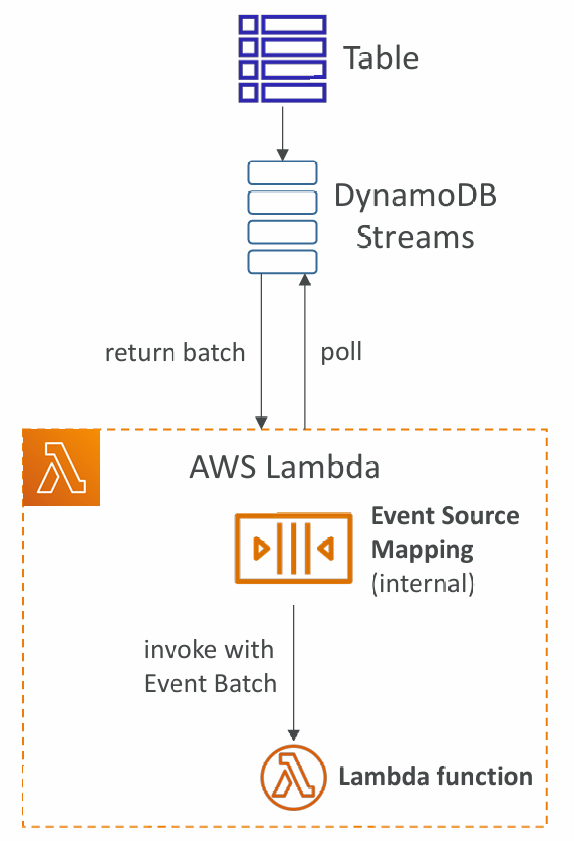
Misc
DynamoDB CLI
--projection-expression: one or more attributes to retrieve--filter-expression: filter items before returned to you- General AWS CLI Pagination options (e.g., DynamoDB, S3, …)
--page-size: specify that AWS CLI retrieves the full list of items but with a larger number of API calls instead of one API call (default: 1000 items)--max-items: max. number of items to show in the CLI (returns NextToken)--starting-token: specify the last NextToken to retrieve the next set of items
DynamoDB as Session State Cache
- It’s common to use DynamoDB to store session states
- vs. ElastiCache
- ElastiCache is in-memory, but DynamoDB is serverless
- Both are key/value stores
- vs. EFS
- EFS must be attached to EC2 instances as a network drive
- vs. EBS & Instance Store
- EBS & Instance Store can only be used for local caching, not shared caching
- vs. S3
- S3 is higher latency, and not meant for small objects
Write Sharding
- Imagine we have a voting application with two candidates, candidate A and candidate B
- If Partition Key is “Candidate_ID”, this results into two partitions, which will generate issues (e.g., Hot Partition)
- A strategy that allows better distribution of items evenly across partitions
- Add a suffix to Partition Key value
- Two methods:
- Sharding Using Random Suffix
- Sharding Using Calculated Suffix
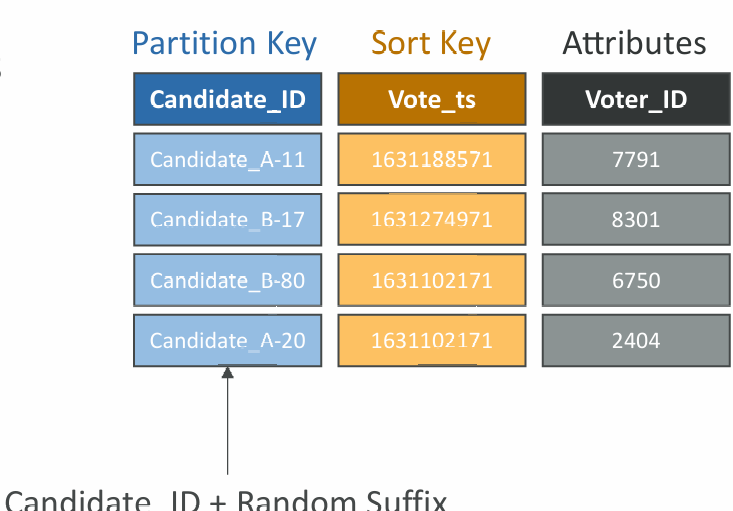
Large Objects Pattern
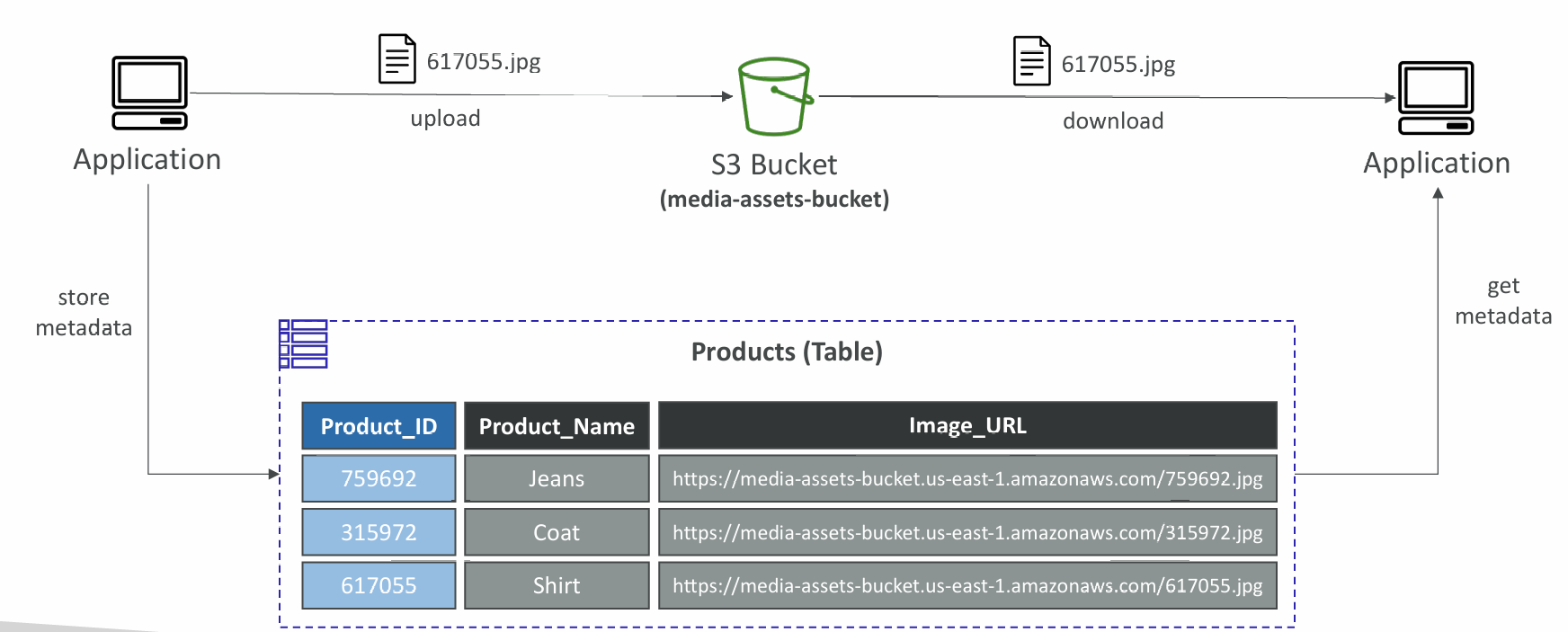
Indexing S3 Objects Metadata
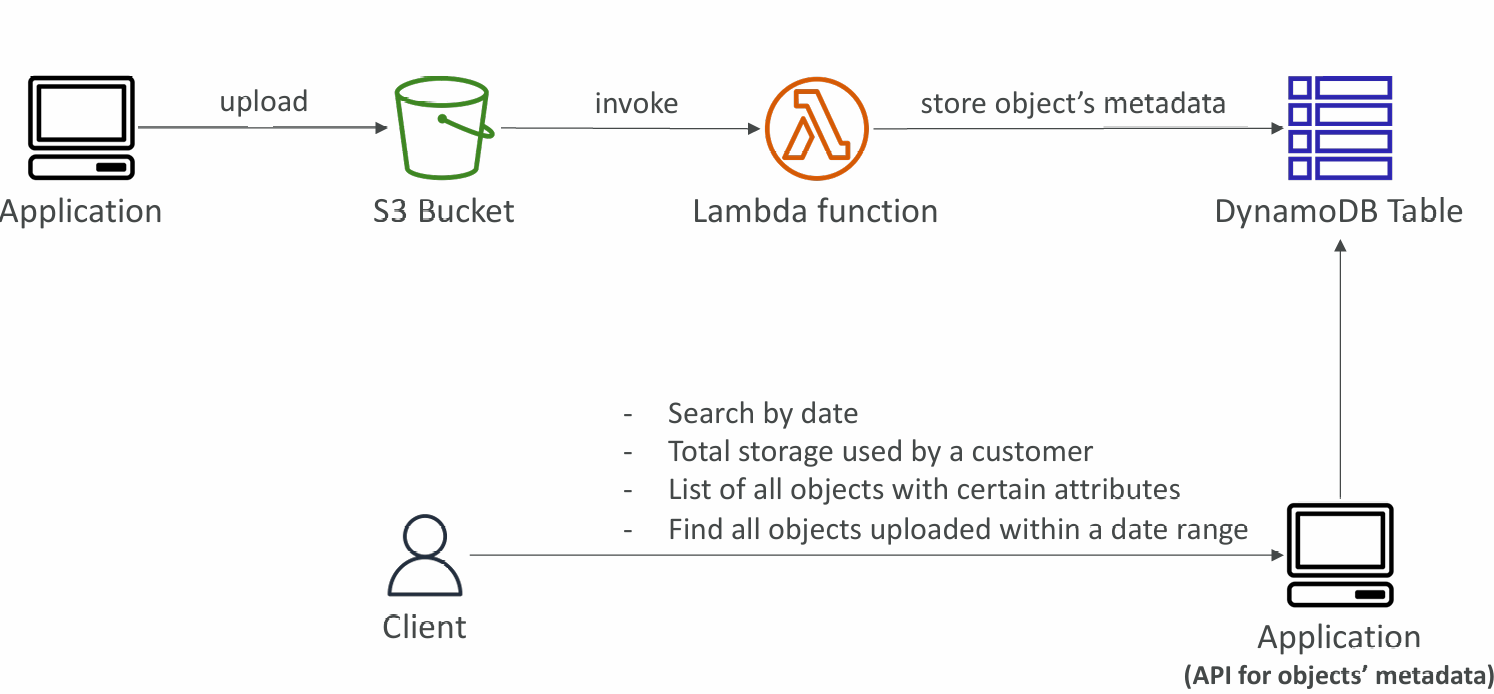
Operations
- Table Cleanup
- Option 1: Scan + DeleteItem
- Very slow, consumes RCU & WCU, expensive
- Option 2: Drop Table + Recreate table
- Fast, efficient, cheap
- Option 1: Scan + DeleteItem
- Copying a DynamoDB Table
- Option 1: Using AWS Data Pipeline
- Option 2: Backup and restore into a new table
- Takes some time
- Option 3: Scan + PutItem or BatchWriteItem
- Write your own code
Security & Other Features
- Security
- VPC Endpoints available to access DynamoDB without using the Internet
- Access fully controlled by IAM
- Encryption at rest using AWS KMS and in-transit using SSL/TLS
- Backup and Restore feature available
- Point-in-time Recovery (PITR) like RDS
- No performance impact
- Global Tables
- Multi-region, multi-active, fully replicated, high performance
- DynamoDB Local
- Develop and test apps locally without accessing the DynamoDB web service (without Internet)
- AWS Database Migration Service (AWS DMS) can be used to migrate to DynamoDB (from MongoDB, Oracle, MySQL, S3, …)
Users Interact with DynamoDB Directly
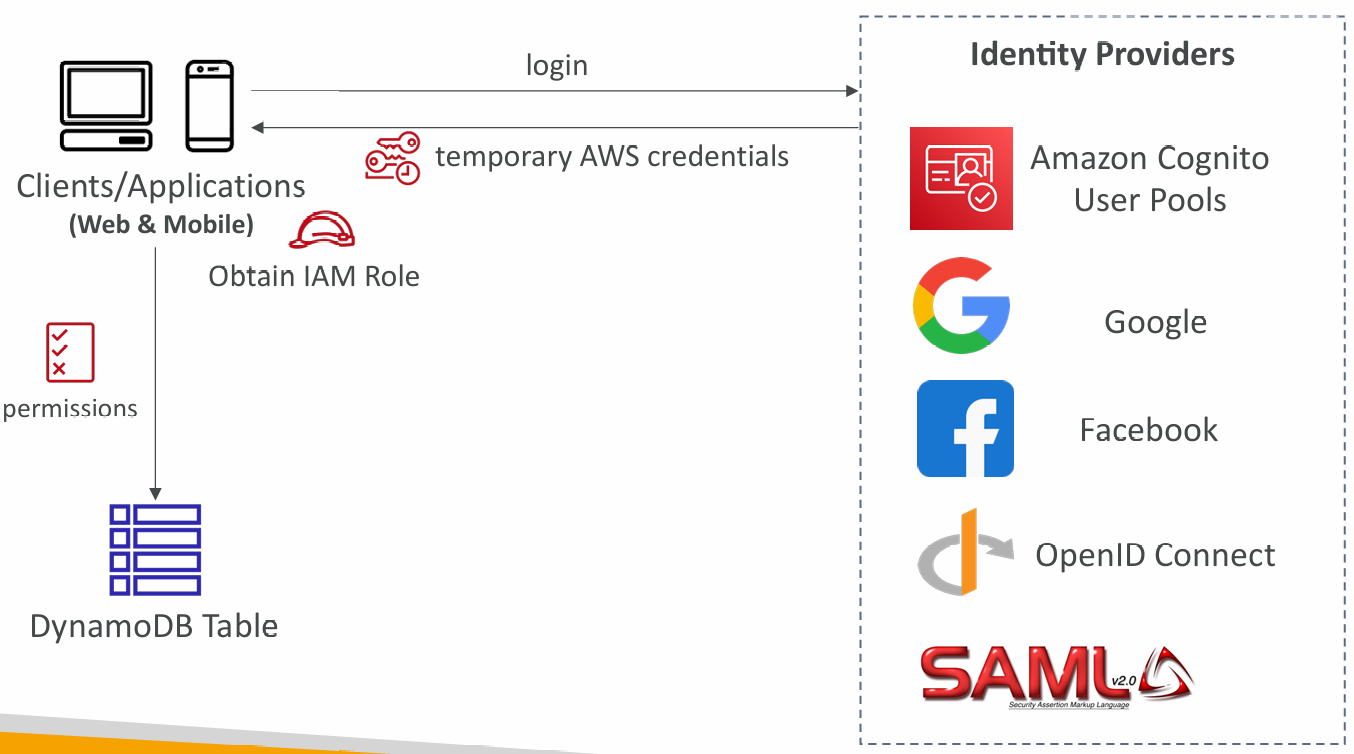
Fine-Grained Access Control
- Using Web Identity Federation or Cognito Identity Pools, each user gets AWS credentials
- You can assign an IAM Role to these users with a Condition to limit their API access to DynamoDB
- LeadingKeys – limit row-level access for users on the Key Primary
- Attributes – limit specific attributes the user can see
